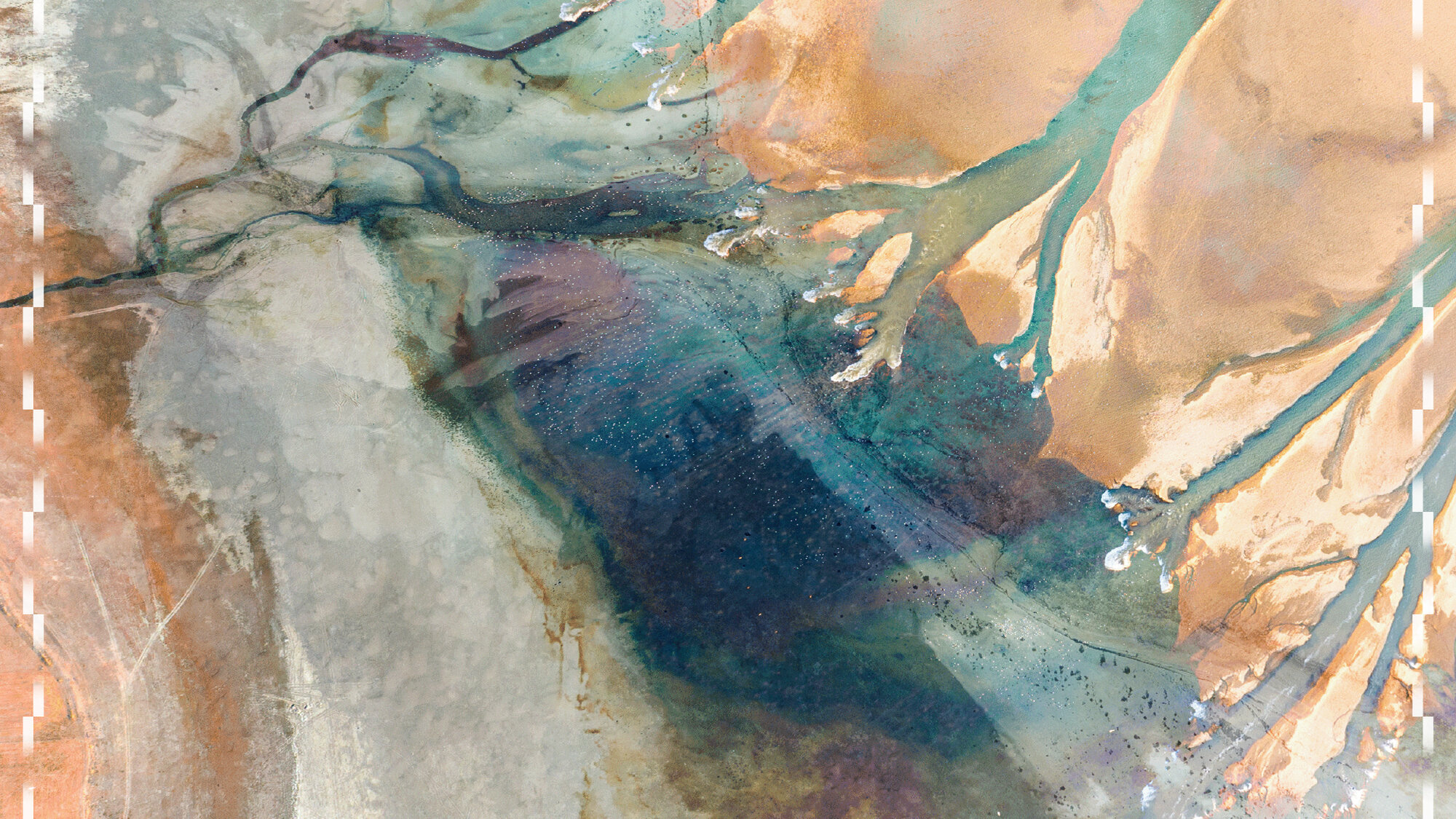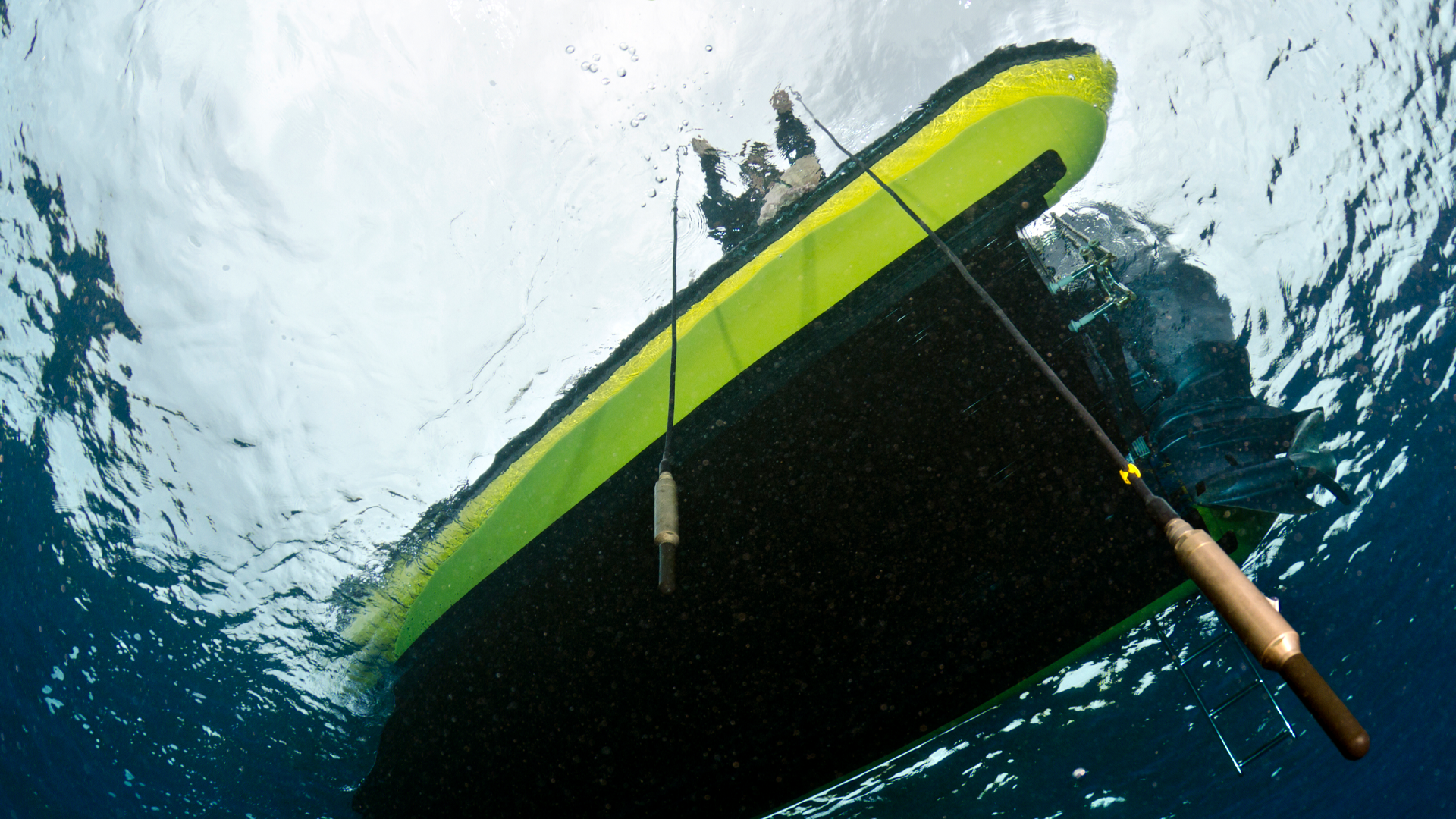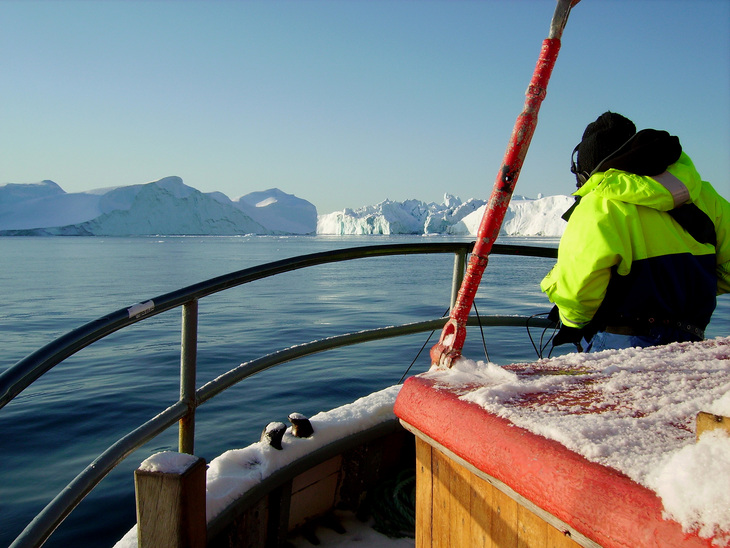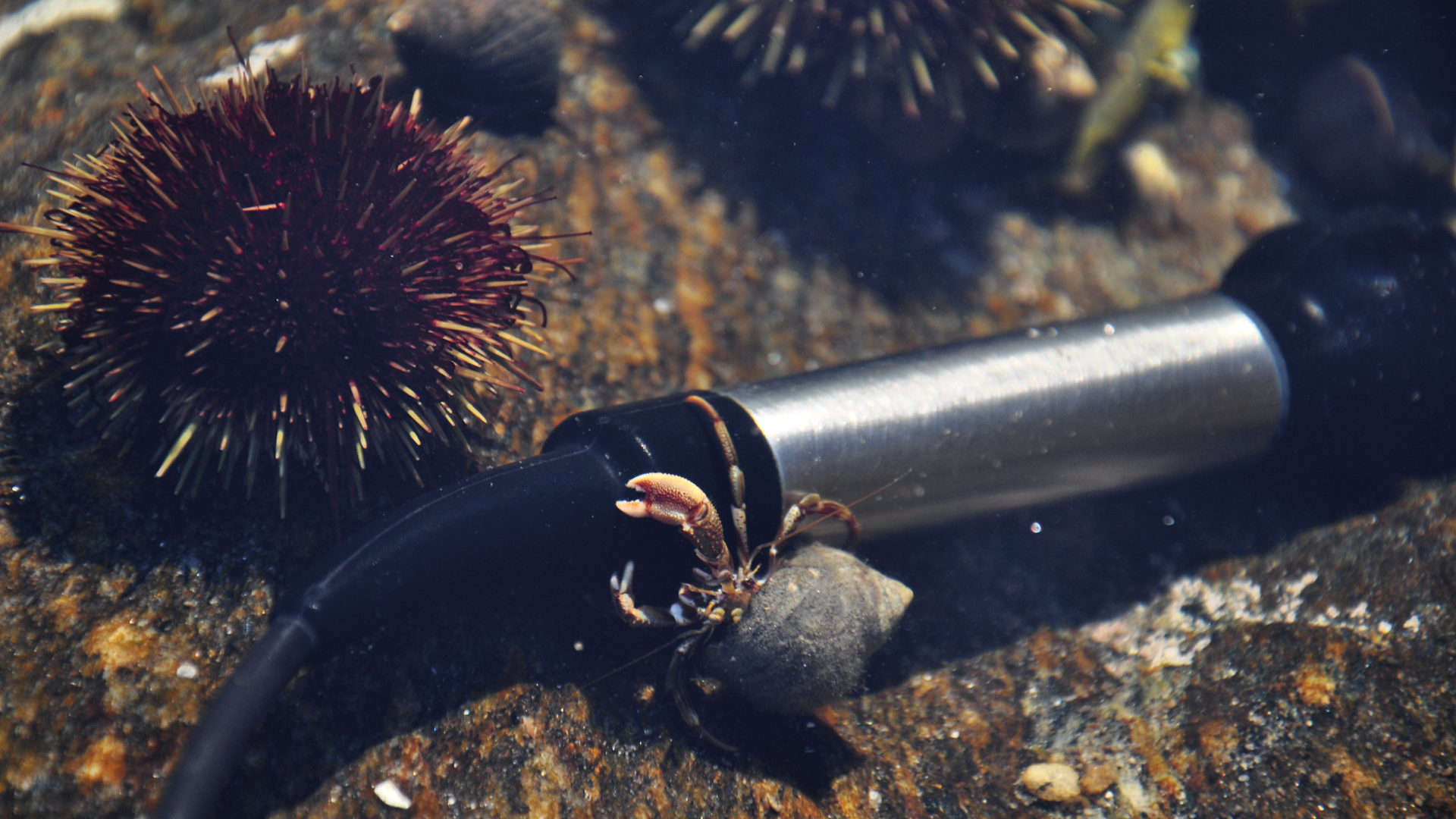Silencing of the Reefs is a long-term (started in August 2011) project by sound artist Jana Winderen, supported by TBA21. Jana Winderen listens into the lively, diverse and dynamic, though threatened acoustic environments of coral reefs and their neighbouring ecosystems. By using the latest technology in terms of recording equipment and hydrophones, she is able to get the best-quality recordings possible.
This project was conceived to be a collaborative effort where Jana’s sound research will benefit from the experience and knowledge of local scientists and communities at the crucial sites she intends to visit. In addition, she will collaborate with international scientists at the forefront of research on coral reefs, crustaceans, and fish communication and oceanography from institutions, such as the Massachusetts Institute of Technology, the Woods Hole Oceanographic Institute in Massachusetts and Boston University, USA.
Silencing of the Reefs will have many outcomes, including installations, concerts, publications, and radio programs, as well as workshops. Jana also sees the voyage in itself and the public she meets on the way and out in the field as an important audience and as participants in this project. This project is based on sounds from the inhabitants of the oceans in general and from coral reefs in particular and the communication of these sounds. She “fishes” the sounds and presents them to an audience to broaden and awaken curiosity about, concern for, and understanding of the ecosystems and habitats that cover 70 percent of our planet by using one more sense, listening.
The coral reefs that Jana envisages to investigate and make sound recordings from in this first part of the project are specifically shallow-water reefs situated by Belize (Lighthouse Reef, Little Cayman Reef, Glover’s Reef), Honduras, Brazil, the fjords of Chile, Cocos Island, Costa Rica, Panama, the Galapagos Islands, the coast of California, and the Sea of Cortez. Further into the project she will also visit reefs in the Asian and Australian part of the Pacific Ocean.
Environment: Coral Reefs
Coral reefs are underwater structures made from calcium carbonate secreted by corals. They are colonies of tiny living animals found in marine waters that contain few nutrients. Most coral reefs are built from stony coral, which consists of polyps that cluster in groups. They create outer skeletons, which protect their bodies. They form some of the most diverse ecosystems on earth, like a rain forest of the seas. Although they do not cover large areas of the sea, they are home to a large percentage of marine species. They are thus great sites to investigate in terms of sound recording and to locate and identify species that use sound to communicate.
Coral reefs are in acute danger of disappearing within 50 years unless serious changes are made right now. They are in danger from trawling and oil drilling; they are threatened by temperature changes and by man-made noise that disturbs the settlement of larvae when they are listening for a healthy reef to settle and grow on. If, for example, the Northwest Passage becomes busy with traffic in the future, this will also have a great impact on the mammals of the oceans since the noise that ships create disturbs the communication between them, which means that they do not congregate and thus cannot mate. In an area in northeast Canada this seems already to be happening. Fish are also endangered by sound pollution, since they too use sound to orient themselves and to communicate with each other. Changing temperatures will also greatly influence both deep water and shallow-water reefs, which at the moment is an acute problem.
Above all acidification is threatening coral reefs and all creatures in the oceans that form hard shells, even down to the smallest Calanus finmarchicus, which is the main food source for fish in the northern seas and extremely important at the bottom of the food chain. Dissolving CO2 in seawater increases hydrogen ion (H+) concentration in the ocean and thus decreases the ocean pH. For coral reefs it is devastating; for example, the stony corals that contain polyps, which cluster in groups, form a hard shell to protect and support their bodies. If the water is too acidic, the shell will not harden, as it would on a healthy stone coral. Creatures in the ocean that depend on calcification (i.e., the forming of hard shells) tend to be at the bottom of the food chain, and if they disappear, it has crucial effects on larger species, which depend on them as source of food. The acidification of the oceans will fundamentally disturb the balance of marine ecosystems.
Another alarming fact is that predicted future CO2 levels have been found to alter sensory responses and behaviour of marine fishes. Changes include increased boldness and activity, loss of behavioural lateralization, altered auditory preferences and impaired olfactory function. Impaired olfactory function makes larval fish attracted to odours they normally avoid, including ones from predators and unfavourable habitats. These behavioural alterations have significant effects on mortality that may have far-reaching implications for population replenishment, community structure and ecosystem function. (See Göran E. Nilsson, Danielle L. Dixson, Paolo Domenici, Mark I. McCormick, Christina Sørensen, Sue-Ann Watson, and Philip L. Munday, in: Nature Climate Change. Published online 15 January 2012. )
Acoustic Environments in the Ocean
The acoustic environment of the oceans is an essential component of life for the creatures inhabiting the seas. The sounds of a sea urchin feeding, a male cod calling out for a mate, a haddock protecting its habitat, or a snapping shrimp stunning its prey are an integral part of the undersea environment. Water is an efficient transmitter of sound waves; sound travels almost five times faster in water than in air, the speed differing according to pressure, salinity, the flow of the current, and temperature. Creatures living in the oceans use sound to communicate, to find a mate, to hunt, and to orient themselves.
Different fish and crustaceans produce different sounds for different purposes; you can identify the species by listening to the sounds they make. Cods, for example, make sound with six drum muscles on their swim bladder. Jana has been able to record different sounds from cod, like the rumble it makes while it is mating and the grunts it makes to protect their prey. A hypothesis is that the female cod chooses their mating partner according to the sound he makes and not according to his size.
Fish hear with their bodies via their lateral line, their bone structure and their swim bladder in a complex way that varies according to species. The mechanosensory system of fishes include: 1 – the hearing of sound pressure oscillations through the inner ears, 2- orientation and body motion sensations (the vestibular system), which is also mediated by the inner ear, -3 detection of hydro mechanical stimulation near the fish that is mediated by the lateral line. The lateral line system consists of an array of neuromasts composed of hair cells and found within pored bony canals and on the epithelium of the head, trunk and tail.
Sounds from the environment, like the cracking of ice 50 meters under the surface of Disco Bay (Greenland) and violent waves crashing against the shores and beaches announce to the fish that land is close by. Underwater mountain chains in the Atlantic Ocean echo the calls of sea mammals. Soundscapes provide a three-dimensional topographical “view” of their world. As species die out, so too does their sound imprint without us knowing that they ever existed, before we are even close to understanding them or their habitats.
Questions
As outlined above, the corals reefs’ ecosystems are in danger of being silenced. Scientists do not yet know how well corals are adapting to these changes and stress factors, but there does seem to be a tipping point at which they can no long recover because there are too many different stress factors.
It has been suggested by scientists that small fish larvae and coral larvae orient themselves actively toward reefs because of the sound that is transmitted by the reefs themselves through their inhabitants. The coral larvae are covered with hair cells, which they likely use to sense sound wave vibrations in the water to decide on the best location to settle. What will happen if the young larvae cannot sense the sounds to guide them? How does human activity and manmade noise influence the process of the coral larvae finding the reef? How do factors such as tide, faces of the moon, and electromagnetic fields influence the navigation w the sites that the larvae have to reach to settle and grow? Can we say that a certain reef has a sound signature that is distinct from those of other reefs?
Is there a difference between how well reefs are recovering at different sites? What is the impact on local communities? How was it in the past, and how has it changed? For example, as a result of pollution from fish oil factories in Chimbote, on the coast of Peru, children have developed asthma and skin disorders. All the fish have died, and corals too. The company believed to be responsible is arguing that it is not at fault, that its factories are sending the wastewater at least one kilometre into the sea. This is just one of thousands examples of how the oceans and their inhabitants are continually treated.
Implications
This is not a scientific project – although it is carried out in collaboration with scientists, designers, and theorists. The methods of collecting the material and communicating the findings are different. The aim is to find and collect from many different sources. As an art project it has the freedom to follow a thought and an idea in a less structured, restricted way. To be able to tap into the findings of others, to share and discuss the findings with others involved, also to get the information from the log of the ship, the current, the temperature, the GPS, the knowledge of the boat crews, and the possibility to invite local scientists to the areas where we are recording makes this voyage more interesting than simply collecting material as a solitary, isolated project.
In addition, an art project has the ability to communicate to an audience that may be unaware of scientific publications and teach them, for example, that fish communicate with sound in the same way that birds communicate through song.
It is also important to emphasize to audiences the scale of what is happening. As Simon Thorrold from the Woods Hole Oceanographic Institution put it: “It is as though we had to cut down the Redwood forest because we wanted to eat the birds that live in the trees.”
This is what is going on underwater. Out of sight, out of mind, is a dangerous attitude that has been encouraged for too long. Because it is independent from a science project, Silencing of the Reefs has its freedom, but of course also limitations in its research possibilities. The conclusions, if there are any, can suggest rather than prove, and, hopefully, inspire – allowing for imaginative and fictitious translations of the material as well as communicating in a more documentary way through talks, radio programs, and workshops.
Photography, Notes, and Log/Blog
At the same time that Jana records sound underwater, she is also recording above water on land to make the story whole, to give the sense of the place above water before we dive in. In addition, Jana is documenting her work with photography, notes, sketches, texts, and sometimes collections of physical materials such as stones, corals, and shells. This is also an important part of this project. Last but not least, the idea is to create an on going log as a tool for the reef project, which also in some way will structure and give the project a timeline that others can use to follow its progress.
Outcomes and Communication
Silencing of the Reefs can have many outcomes, including installations, concerts, publications, and radio programs, as well as workshops with local people as well as international specialists. Jana also sees the voyage in itself and the public she meets on the way and out in the field as an important audience and as participants in this project
.
One outcome Jana has started working on is a commission for the Thyssen-Bornemisza Art Contemporary Foundation (TBA21, Vienna) – a collaboration between Neri Oxman (Professor of Media Arts and Sciences at the MIT Media Lab), Tony Myatt (Professor of Sound, Surrey University) and Jana Winderen on the creation of an “ocean pavilion” – a novel architectural structure that functions at once as a habitable environment and acoustical landscape, representing and celebrating the ocean.Jana is also working towards concert performances, a vinyl release and a book publication of the project.
Methodology: Collecting Material
On the TBA21 research vessel Dardanella and other exploration vessels the recording and collection of material are the most important tasks, so the time on board should be used as much as possible for recording. As mentioned above, the preparation time on land beforehand and logging time afterward are essential for getting to the best sites and making the best recordings. It is preferable to spend a substantial amount of time at one location or in a limited area so that it is possible to go back to interesting spots at different times of the day or night and at different tides. It is ideal to have the time to talk to locals and then go out again in the same area.
Jana records with four hydrophones to get a feeling of space and depth, and then to move into multichannel installations. It is most interesting to make multichannel installations or a multichannel live set with this kind of material, so that the audience feels immersed in the sound as much as possible. Moreover, Jana is experimenting with hydrophones set up in spheres, as with the spheres by Timo Klinge at the company Sonar Surround. In recent years Jana has been working with Tony Myatt, Professor for Sound at Surrey University (before Director of the Music Research Center at York University) and his team on several installations.
The method Jana uses to record is concentrated listening out at the sites, and then move towards and follow the interesting sounds. She is working on techniques to avoid the sound of the slapping of waves against the boat, which transmits very deep down into the ocean. One way of doing this is to let the hydrophones drift off with the help of buoys though still being able to actively listen to what she will record, since it is important to be able to adjust the recording levels, and to listen in for the interesting sound. She has also been testing to record form canoes which makes less sound than a boat. Another method is to go to a site and wait until what you are expecting to be there turns up. It is also possible to use buoys, which would send the sound live to, for example, an installation, or a live set on land – this can be mixed with pre-recorded sounds from the same site, for example. There are many buoys already in suitable locations, but a problem is that the sound quality is not good enough to use. If we were able to send and transmit sound of high resolution from such a buoy, it would be highly advantageous to be able to follow certain coral sites over a longer period of time, in different seasons, through spawning, at high and low tide, at different temperatures, when different migrating species of fish and mammals pass it, and so on.
Water that is as calm as possible is the ideal recording situation. No other ship traffic is also essential, since boat motors are extremely load compared to the sound of fish and crustaceans, a motor sound even kilometres away will be ruining the recording. On the coral reefs themselves Jana intends to record at different times of day and night, at various depths, and at various distances from the reefs. She will also record in the mangroves since certain species of fish also inhabit these ecosystems in connection and combination with the reefs. It is also important to know when different species and the corals themselves are spawning, when they are active, when certain species are migrating over the reef, and so on.
Experience and Equipment
Over the last six years Jana Winderen has focused her work on the inhabitants of the oceans, rivers, lakes, and glaciers in locations in Asia, North America, Southern Europe, and Northern Europe (particularly Greenland, Norway, Iceland, and the Barents Sea). In the mid-1980s she studied science to become a marine biologist and finds herself now back working with the same issues that concerned her then; the inhabitants of the oceans and the well-being of the ecosystems.
For several years, Jana has also been running workshops on hydrophone recording (the most recent was on the coast of Norway with MA students in sound art); for sound artists in Seoul, South Korea (with Mike Harding); and in Montreal on the St. Lawrence River with local artists and in collaboration with Hexagon. Also, through travelling in quite extreme situations—like hanging in a crevasse on the Folgefonna Glacier in Norway with the hydrophones 25 meters under her in the ice, or on the coast of Greenland recording 60 meters under the sea ice, or in the Icefjord Kangia by Ilulissat in Greenland, or in the Barents Sea with a research team from the Institute of Marine Research in Bergen, Norway—she has gained experience with cold and rough climates in various weather conditions.
Jana has developed recording methods for underwater work, and is currently collaborating with a company in Germany, Sonar Surround, by testing their hydrophones and their development towards making multichannel hydrophone recordings. She records among others with one Reson TC4032 hydrophone, four DPA hydrophones (three with 25-meter cables and one with a 90 meter cable) and uses a four-track Sound Devices 744T hard disk recorder and a Mix Pre with her hydrophones. She is currently also experimenting with ultrasound recordings both under and above water. This to be able to record echolocation sound from smaller Odontoceti, and possibly other species that are using sound in the ultrasound range.
Biography
Jana Winderen is an artist educated in Fine Art at Goldsmiths College in London, and with a background in mathematics, chemistry, biochemistry and fish ecology from the University in Oslo. ince 1993 she has worked as an artist, curator and producer. She currently lives and works in Oslo.
Jana Winderen researches the hidden depths with the latest technology; her work reveals the complexity and strangeness of the unseen world beneath. The audio topography of the oceans and the depth of ice crevasses is brought to the surface. She is concerned with finding and revealing sounds from hidden sources, both sounds inaudible for the human senses and from places and creatures difficult to access.
Recent sounds work include “Out of Range” commissioned by Deutschlandradio, Kultur, Germany, (2014), “Ultrafield” commissioned by MoMA, The Museum of Modern Art, New York, (2013), “Water Signal”, commissioned by The Guggenheim Museum and the Unsound festival in New York for the Stillspotting project, “ultraworld”, a commission by Sound and Music for the listening room at BEOPEN, Trafalgar Square, London (2012), a concert and talk at MIT, Boston, in relation to the Tribute to Commemorate Electro-acoustic pioneer Marianne Amacher; “Survivors of the Waterworld – Measuring Pollution by Sound” for Gøteborg International Biennial for Contemporary Art (2011); “Energy Field” live at ARS Electronica Festival for receiving the Golden Nica in 2011; “Between Dry Land”, commissioned for the installation “The Morning Line” (by Matthew Ritchie) for the Thyssen-Bornemisza Art Contemporary, opened in Istanbul May 2010. “Spawning Ground – from Coquet Head to the North Sea” was also commissioned for the AV festival in Newcastle (2010), and in the same year Jana also opened a permanent sound installation at the Knut Hamsun Centre in Hamarøy, Norway.
Recent releases include the 12” Vinyl, “Debris” (2012), the album “Energy Field” (2010), “Heated: Live in Japan” (2009), all on Touch (UK); the audio cassette “The Noisiest Guys on the Planet” (2009) on Ash International (UK); the USB stick, “Ants”; the digital download “Submerged” (2009), also on Touch, and the 7” vinyl “Surface Runoff” (2008) on Autofact (USA).
She is currently working on a new CD release for Touch (UK), is participating in the project T-BA21 Academy with the project “Silencing of the reefs” supported by T-BA21, and she is in the process of realizing the commissioned permanent outdoor sound installation “Raft of Ice” for the new American Embassy in Oslo.
Artist’s Statement
"I like the immateriality of a sound work and the openness it can have for both associative and direct experience and sensory perception. I have been busy searching for sounds from hidden sources, frequencies which are not possible for us to perceive, as well as from places and creatures that are hard to access. Over the last seven years I have collected recordings made by hydrophones, from rivers, shores and the ocean in Asia, Europe and America, from glaciers in Greenland, Iceland and Norway. In the depths of the oceans there are invisible but audible soundscapes, about which we are largely ignorant, even if the oceans cover 70% of our planet. I am also experimenting with different types of microphones to collect sounds which are not obviously recognisable, but give room for broader, more imaginative readings or sounds that are unreachable for the human senses, such as ultrasound, I use these sounds as source material for composition in a live environment or to create installations, also for film, radio, CD, cassette and vinyl productions."
–Jana Winderen, 2014






































